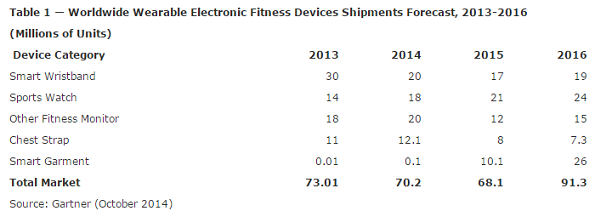 Wearable Electronic Fitness Devices Market Still Poised for Strong Growth
Wearable Electronic Fitness Devices Market Still Poised for Strong Growth
Wearable electronic devices for fitness shipments are forecast to reach 68.1 million units in 2015, down from 70 million units in 2014, according to Gartner, Inc. This temporary dip in sales will be driven by an overlap in functionality between smart wristbands, other wearable fitness monitors and smartwatches. However, the market for smart wristbands and other fitness monitors will rebound in 2016 because of versatile designs and models with lower-cost displays.
“Fitness wearables are used for tracking health, which goes hand-in-hand with fitness and wellness,” said Angela McIntyre, research director at Gartner. “Consumers will be able to integrate the data from most wearables into a single account where their data can be analyzed using cognizant computing to provide useful insights to wearers. Funding initiatives from Qualcomm, Apple (HealthKit), Google (Google Fit), Samsung (S.A.M.I.), Microsoft, Nike and Intel, among others, will build on early innovation in wearable fitness and health monitoring and create the infrastructure for merging data relevant to health and fitness.”
The five main fitness wearable form factors are smart wristbands, sports watches, other fitness monitors, heart rate monitor chest straps and smart garments.
Sports watches and chest straps are well established, compared with smart wristbands first popularized by the Jawbone Up, which launched in 2011. However, Gartner believes that the smart garment product category has the greatest potential for growth going forward because the category is emerging from the testing phase and smart shirts are available to athletes and coaches of professional teams. Smart garment shipments are forecast to grow from 0.1 million units in 2014 to 26 million units in 2016 (see Table 1).

For the present, however, smart wristbands and other fitness monitors are the most popular form factors.
“Smartwatches having retail prices of $149 or more will typically have the capability to track activity and have accelerometers and gyroscopes similar to their smart wristband cousins,” said Ms. McIntyre. “The smartwatches differ from smart wristbands in that smartwatches need to display the time and have a user interface oriented around communication. However, some smart wristbands have the ability to display and send text messages. The overlap in functionality between smart wristbands and smartwatches is expected to continue.”
Gartner further predicts that in 2018 through 2020, 25 percent of smart wristbands and other fitness monitors will be sold through nonretail channels. During this time scale, smart wristbands and other fitness monitors will be offered increasingly by gyms, wellness providers, insurance providers, weight loss clinics or employers, sometimes at subsidized prices or for free.
These companies will serve as a growing distribution channel for device manufacturers. The new channels also result from fitness monitors being integrated into employee badges or identification bracelets for access control. Business-to-consumer (B2C) companies will have rewards or gamification linked to the use of wearables as a way of keeping customers engaged with their brands.

